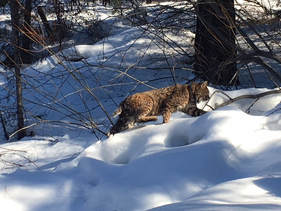|
COYOTES &
BOBCATS |
We are examining the movements and population dynamics of two common mesopredators, coyotes and bobcats, within the context of the greater wildlife community. The recent wolf recolonization has created a mosaic of variation in large carnivore presence. We are using a combination of GPS tracking technology, fecal genotyping, and cameras at kill sites to jointly examine facilitation and suppression. We hypothesize that scavenging is a critical yet overlooked factor determining mortality risk for mesopredators, creating hotspots of intraguild interactions across the landscape. Carrion may thus present a “fatal attraction” whereby local-scale clustering of competing carnivores leads to landscape-scale suppression of subordinate mesopredators. Coyotes and bobcats are being used to test this hypothesis, because they differ strongly in their scavenging activity but are otherwise ecologically similar.
Funding: National Science Foundation
Collaborators: Jonathan Pauli (U Wisconsin), Lisa Shipley (Washington State U), WDFW
UW Project Leads: Laura Prugh (PI), Becca Windell (PhD Student)



